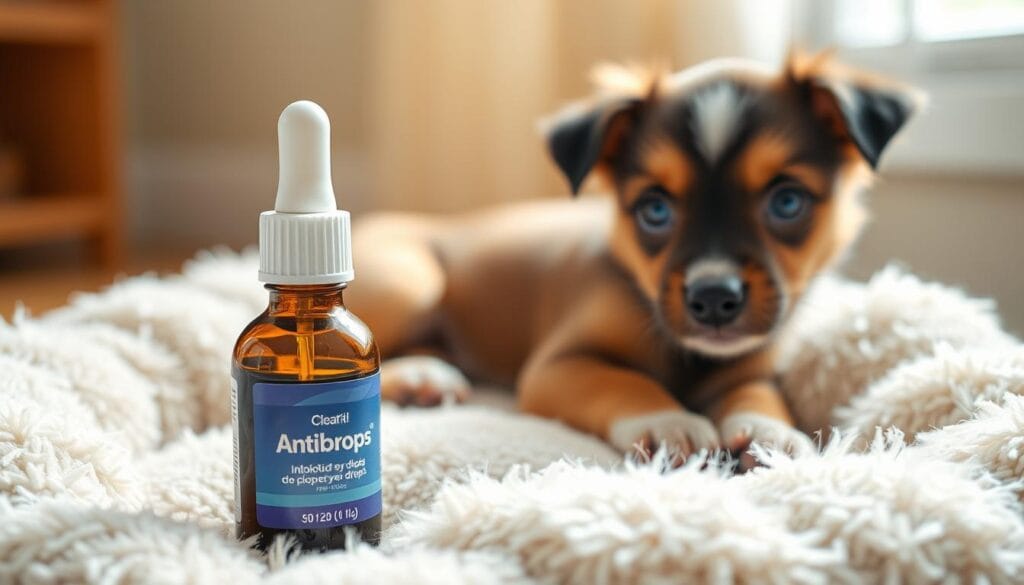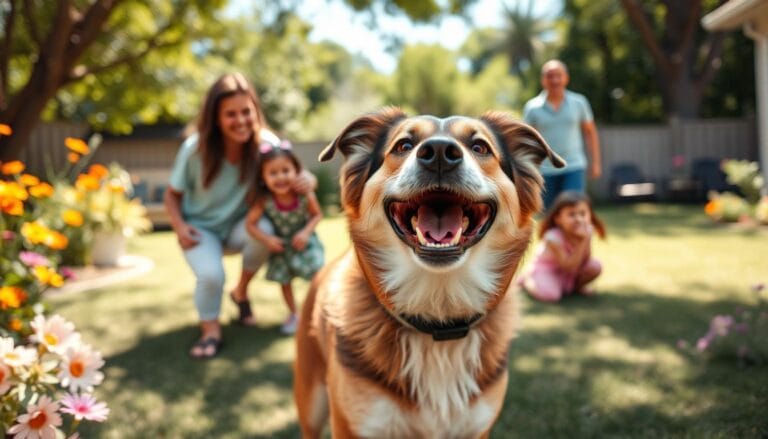Eye Drops for Dogs: The Best Solutions for Common Eye Issues
As a dog owner, you might wonder what to do when your pet has eye problems. This could be infections or allergies. Can eye drops really help, or are they just a quick fix? It turns out, eye drops for dogs, including antibiotic ones, are key in treating your pet.
Table of Contents
Eye drops can help with many issues, like dry eye, glaucoma, and infections. It’s important to know when and how to use them right. Your vet can guide you on the best treatment for your dog, which might include eye drops or other meds.
Key Takeaways
- Eye drops for dogs can be used to treat various conditions, including infections and allergies.
- Antibiotic eye drops for dogs may be prescribed to treat bacterial infections.
- It’s essential to consult with a veterinarian before starting any treatment, including eye drops.
- Eye drops can be used in conjunction with other medications to provide relief and promote healing.
- Proper administration and dosage are critical to ensure the effectiveness of eye drops for dogs.
- Regular check-ups with your veterinarian can help prevent and detect eye problems early on.
Understanding Your Dog’s Eye Health
As a dog owner, knowing how your dog’s eyes work is key. The nictitating membrane, or third eyelid, protects their eyes from dirt and harsh conditions. It helps remove debris, lowering the chance of eye infections. Using eye drops for dogs regularly can also keep their eyes clean and healthy.
Dogs also have natural tears to lubricate and protect their eyes. But, some dogs may face eye issues like allergies. These can cause discomfort and affect their vision. Allergy eye drops for dogs can help ease allergy symptoms and reduce swelling.
Common Eye Problems in Dogs
Dogs can get eye problems like conjunctivitis, keratitis, and glaucoma. These issues can stem from infections, allergies, or injuries. It’s vital to spot signs like redness, swelling, or discharge and get vet help fast.
Signs Your Dog Needs Eye Treatment
Look out for signs like redness, swelling, discharge, or avoiding light. If your dog squints or rubs their eyes, they might need treatment. Regular vet visits can catch eye problems early, preventing serious issues.

The Importance of Early Detection
Spotting eye problems early is critical for your dog’s health. Regular vet visits can catch issues before they worsen. By understanding your dog’s eye health and recognizing signs, you can keep their eyes healthy and ensure their well-being.
Different Types of Eye Drops for Dogs
As a dog owner, knowing about eye drops for your pet is key. You can pick from antibiotic, anti-inflammatory, allergy, and lubricating eye drops. Each one has its own purpose. Always talk to a vet to find the right eye drop for your dog.
Antibiotic eye drops fight bacterial infections like conjunctivitis. This infection spreads easily among dogs and is caused by Staphylococcus and Streptococcus. Anti-inflammatory drops, on the other hand, help reduce eye swelling and inflammation. They’re great for allergic conjunctivitis or dry eye.
Characteristics of Each Type
- Antibiotic eye drops: used to treat bacterial infections, such as conjunctivitis
- Anti-inflammatory eye drops: used to reduce inflammation and swelling in the eyes
- Allergy eye drops: used to treat allergic reactions and conjunctivitis
- Lubricating eye drops: used to treat dry eyes and provide moisture
Always follow your vet’s advice when using eye drops on your dog. Using them wrong can harm your dog or make them less effective. About 10-20% of dogs get eye allergies, and some need eye drops. Knowing about different eye drops helps you care for your dog’s eyes better.

When to Seek Veterinary Care for Eye Issues
As a dog owner, knowing when your pet needs vet care for eye issues is key. Some problems, like conjunctivitis or corneal ulcers, can be treated with eye drops for dogs or other meds. But, issues like glaucoma or cataracts might need surgery.
Look for signs like redness, discharge, or squinting in your dog’s eyes. Your vet can figure out what’s wrong and suggest the right treatment. Remember, don’t use human eye drops on dogs without a vet’s okay. It could hurt them more.
Regular vet visits are important to catch eye problems early. Your vet can do a full eye exam and tell you the best treatment. Getting vet care when needed helps keep your dog’s eyes healthy and avoids bigger problems.
In emergencies, like sudden vision loss or extreme pain, get to a vet fast. Being proactive and getting vet care when needed protects your dog’s eye health. This prevents serious complications.
The Benefits of Prescription Eye Drops
As a dog owner, you want the best for your pet’s eye health. Prescription eye drops can treat many eye issues, like infections and chronic conditions. They help prevent serious problems too. With up to 20% of dogs facing eye issues, knowing about these drops is key.
Antibiotic eye drops are great for bacterial infections, helping 60% of cases. They also manage chronic issues like dry eye. Plus, they stop glaucoma, a big risk that can cause blindness in over 40% of dogs if not treated.
- Treatment of infections: Antibiotic eye drops for dogs can effectively treat bacterial infections, reducing the risk of complications.
- Managing chronic conditions: Prescription eye drops can help manage conditions like dry eye, reducing discomfort and preventing further complications.
- Prevention of complications: Eye drops for dogs can help prevent complications like glaucoma, which can lead to blindness if left untreated.
Using prescription eye drops can keep your dog’s eyes healthy. This reduces the chance of serious issues and improves their life quality. Always talk to a vet to find the right treatment for your dog’s eye problem.
How to Properly Apply Eye Drops to Your Dog
Applying eye drops for dogs needs the right technique. This ensures the drops work well and are safe for your pet. Before you start, wash your hands well and clean the eye area to avoid infections. It’s also key to keep the eye drop applicator tip clean to prevent contamination.
Many dog owners ask if can dogs use human eye drops. But it’s not a good idea. Human eye drops can harm dogs. Always use eye drops for dogs made for them. Your vet can tell you the right amount and how to use it.
To put the drops in, hold your dog’s head gently and place the applicator tip near the eye. Watch for signs of discomfort or stress. Adjust as needed. Use treats and praise to make it easier for your dog.
Some important tips for applying eye drops to your dog include: * Use the right amount and method * Keep the applicator tip clean * Don’t use human eye drops; use eye drops for dogs instead * Be patient and gentle with your dog By following these tips and talking to your vet, you can make sure your dog gets the eye care they need to stay healthy and happy.
Natural vs. Medicated Eye Drops for Dogs
Keeping your dog’s eyes healthy is very important. You might wonder if to use natural or medicated eye drops. Natural drops are good for minor issues, while medicated drops treat serious problems like infections or inflammation.
Talking to a vet is key to choosing the right drops. They can guide you between natural and medicated options. For example, if your dog has dry eyes, they might suggest antibiotic eye drops or saline eyewashes.
Here are some main differences between natural and medicated drops:
- Natural drops are for minor issues and can be bought without a prescription.
- Medicated drops, like allergy drops, are for serious conditions and need a vet’s advice.
The choice between natural and medicated drops depends on your dog’s needs. By getting advice from a vet, you can ensure your dog’s eyes stay healthy and comfy.
Safety Considerations and Possible Side Effects
When using eye drops for dogs, it’s key to think about side effects and safety. Some human eye drop ingredients, like naphazoline and brimonidine, can harm dogs. Always follow your vet’s advice and watch how your dog reacts to the drops.
Common side effects of anti-inflammatory eye drops for dogs include eye irritation, stinging, swelling, and redness. Rarely, dogs might have allergic reactions that need quick vet care. Also, some dogs can become sensitive to certain ingredients over time.
To lower the chance of side effects, do the following:
- Stick to the dosage and schedule your vet gives you
- Keep an eye on how your dog reacts to the drops
- Keep the drops in a cool, dry spot, out of sunlight
- Don’t use human eye drops on dogs, as they can be dangerous
By taking these steps and knowing about possible side effects, you can make sure eye drops for dogs and anti-inflammatory eye drops for dogs are used safely and effectively.
Can You Use Human Eye Drops on Dogs?
It’s important to use the right products for your dog’s eye health. You might ask, can you use human eye drops on dogs? The answer is no. Human eye drops are not safe for dogs because they can harm them.
Risks and Dangers
Using human eye drops on dogs can lead to serious problems. These drops can irritate or even poison dogs. It’s always best to talk to a vet before using any eye drops on your dog.
Safe Alternatives
Look for eye drops for dogs that are made just for them. These drops are safe and can help soothe your dog’s eyes. Your vet can help pick the best drops for your dog’s needs.
Remember, your dog’s eye health is key. Always choose products made for dogs. This way, you can keep your dog’s eyes happy and healthy.
Preventive Eye Care for Your Dog
As a dog owner, you are key to keeping your pet’s eyes healthy. Regular vet visits and daily care can stop eye issues early. Eye drops for dogs are important for pets at risk of eye infections or swelling.
Preventive eye care for dogs includes:
- Daily check of your dog’s eyes for dirt, discharge, or oddities
- Regular vet visits to watch your dog’s eye health
- Using antibiotic eye drops for dogs as your vet suggests for infections
By taking these steps and working with your vet, you can keep your dog’s eyes in top shape. Early detection and prevention are vital for your dog’s health and happiness.
Breed-Specific Eye Care Needs
As a dog owner, knowing about eye problems in certain breeds is key. For instance, Pugs, Shih Tzus, and Bulldogs often face corneal exposure and dystrophies. Dogs with long hair, like Sheepdogs and Poodles, are at risk for eye infections and irritation. Regular veterinary check-ups can spot these issues early. Eye drops for dogs might be needed for dry eye or allergies.
Some breeds are more likely to need allergy eye drops for dogs because of their genetic makeup. About 20% of dogs can get eye allergies, causing discomfort and serious problems if not treated. Knowing your breed’s eye care needs helps protect their vision and health.
For the best eye care, work closely with your vet to find the right treatment. This might include eye drops for dogs or other meds, along with regular check-ups. A proactive, breed-specific eye care plan ensures your dog has healthy vision and well-being for life.
Cost Considerations and Insurance Coverage
As a dog owner, you want the best for your pet, including their eye health. The cost of eye drops for dogs varies by type and brand. Anti-inflammatory eye drops for dogs might be pricier but are needed for some conditions.
Eye care for dogs can get expensive fast. Treating an eye infection can cost between $100 and $500 or more. This depends on the condition’s severity and where you live. Some pet insurance might help with these costs, but check your policy first.
Here are some cost factors for your dog’s eye care:
- Cost of antibiotic drops for eye infection treatment: $15–$25, excluding vet visit fees
- Initial consultation fee and follow-up costs for eye treatments: $60 to $200
- Cost of cataract eye surgery for dogs: $2,600 to $3,800, depending on the method and intraocular lens use
Pet insurance can help with some costs, but know what it covers. Research and plan to ensure your dog gets top eye care without overspending.
Conclusion: Ensuring Your Dog’s Optimal Eye Health
Keeping your dog’s eyes healthy is key to their overall well-being. As a pet owner, you have a big role in watching their vision and spotting any problems. Eye drops for dogs can help with many eye issues, like infections and allergies.
Regular vet visits are important for catching eye problems early. Working with your vet, you can create a special eye care plan for your dog. This plan might include the right eye drops. Taking these steps can greatly improve your dog’s life and lower the chance of serious eye issues.
Even though human eye drops aren’t safe for dogs, there are special drops made just for them. By focusing on your dog’s eye health, you help them keep their vision sharp. This way, they can stay happy and active.
FAQ
What are the common eye problems in dogs that may require the use of eye drops?
Dogs can face many eye issues, like allergies, infections, and dry eyes. These problems might need different eye drops. This includes antibiotic, allergy, anti-inflammatory, and lubricating drops.
What are the signs that my dog needs eye treatment?
Signs your dog might need eye care include eye-rubbing, redness, and squinting. Also, if they’re sensitive to light. Early treatment is key, so regular vet visits are important.
What are the different types of eye drops available for dogs?
There are several eye drops for dogs. Antibiotic drops fight infections, while allergy drops help with allergic reactions. Anti-inflammatory drops reduce swelling, and lubricating drops help with dry eyes. Your vet will choose the right one for your dog.
When should I seek veterinary care for my dog’s eye issues?
Seek vet care for any eye problems in your dog. Delaying can cause serious issues. Your vet can diagnose and prescribe the right treatment.
What are the benefits of using prescription eye drops for dogs?
Prescription eye drops can treat infections and manage chronic conditions. They can also prevent complications. Antibiotic drops are often used for bacterial infections.
How do I properly apply eye drops to my dog?
To apply eye drops, wash your hands first. Then, gently hold your dog’s eye open and put in the drops as your vet instructs. Always follow the dosage carefully.
Can I use human eye drops on my dog?
It’s not safe to use human eye drops on dogs. They might have ingredients harmful to dogs. Always check with your vet before using any eye drops on your dog.
What are the safety considerations and possible side effects of using eye drops in dogs?
Always follow your vet’s instructions when using eye drops. Watch for signs of irritation or sensitivity. Store the drops properly and handle them carefully.
How can I prevent eye problems in my dog and maintain their optimal eye health?
Keep your dog’s eyes clean daily and visit your vet regularly. Your vet may suggest eye drops as part of your dog’s care routine.
Are there any breed-specific eye care needs I should consider for my dog?
Yes, some breeds are more likely to have eye problems. Talk to your vet about a care plan for your dog’s breed. This might include specific eye drops.
There are no reviews yet. Be the first one to write one.







